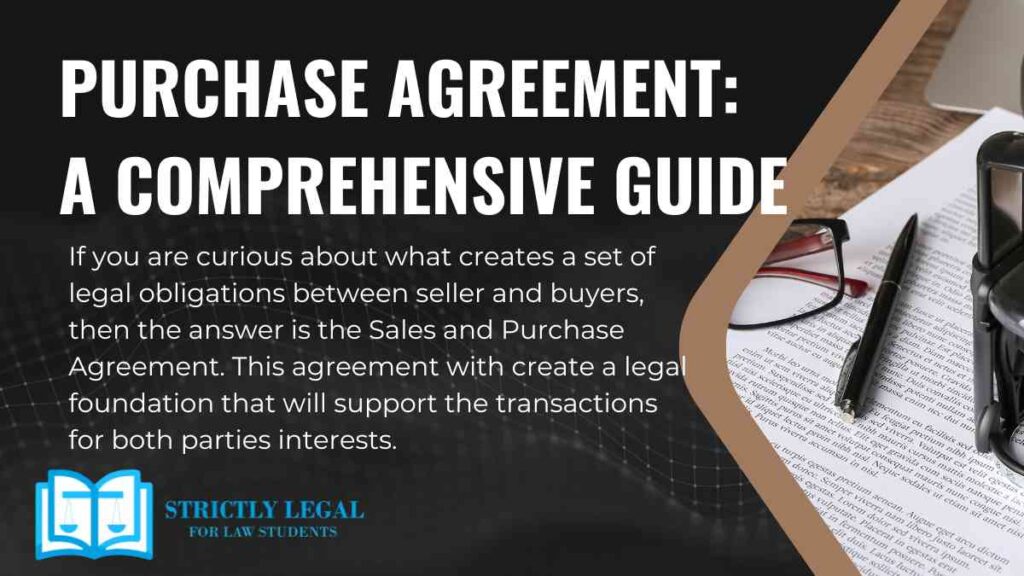Are you looking forward to legalizing your transaction with your buyer? If you are curious about what creates a set of legal obligations between seller and buyers, then the answer is the Sales and Purchase Agreement. This agreement with create a legal foundation that will support the transactions for both parties interests. Read on to get a detailed idea about the Sales and Purchase Agreement.
Table of Contents
What precisely is a Sales and Purchase Agreement?
A sales and purchase agreement (SPA), which establishes the terms and conditions of a transaction involving the acquisition of products or services, is a legal contract between the buyer and a seller. The price, payment terms, delivery date, warranties or guarantees, and other pertinent terms and conditions are frequently included in the SPA.
The SPA outlines the rights and responsibilities of both the buyer and the seller and acts as a legally binding contract that stays between the parties. Both parties’ interests are protected, and a clear understanding of the transaction is provided. The SPA establishes the parameters of the transaction and offers a framework for the purchase or sale of goods or services once it has been signed. It then has legal force.
Why do you need to make a Purchase Agreement?
A sales and purchase agreement (SPA), which establishes a legally binding framework for the sale or purchase of goods or services, is necessary. A SPA acts as a detailed and thorough statement of a list of the terms and conditions of the transaction, lowering the possibility of misunderstandings, legal conflicts, and other problems.
To safeguard the interests of both parties, the buyer and the seller, an SPA is required. It guarantees that the buyer will receive the products or services they ordered at the price and time they agreed upon. It also offers an assurance that the products or services will be of the quality and other standards agreed upon.
A SPA assures the seller that they will be compensated for the goods or services they have rendered. Additionally, it shields them from potential losses brought on by late payments, missed deliveries, or other problems.
In conclusion, an SPA is crucial for any business transaction since it ensures that everything happens as planned and in accordance with the terms and circumstances that were agreed upon. It offers a level of security and predictability that is advantageous to all parties to the transaction.
How does SPA Benefit you?
- Offers a defined framework for the transaction.
- Aids in lessening misunderstandings and conflicts.
- Guards both the buyer’s and the seller’s interests.
- Offers payment and delivery assurance.
- Assists in making sure the transaction goes off without a hitch.
- Offers both parties legal defense.
- Offers a copy of the transaction’s record.
- Assists in increasing mutual trust between the buyer and seller.
What is a Contract of Sales and What All does it Include?
A legally binding agreement between the vendor and the buyer for the purchase of products or services is known as a contract of sale. It contains information about the cost, the methods of payment, the date of delivery, any warranties or guarantees, and other pertinent terms and conditions.
The selling contract establishes the parties’ rights and obligations and acts as a foundation for the transaction. Additionally, it offers both the buyer and the seller legal protection. The contract of sale is an important document since it ensures that the transaction goes through without a hitch and in accordance with the terms and conditions set forth in it. It offers a guarantee of payment and delivery and lessens misunderstandings and disagreements.
How should an SPA look like?
[Your Company Logo]
SALES AND PURCHASE AGREEMENT
This agreement (“Agreement”) was made and entered into on [Date] by and between [Seller’s Name and Address] (“Seller”), and [Buyer’s Name and Address] (“Buyer”).
1. Sale and Purchase of Goods. Seller agrees to sell, and on the other side, Buyer agrees to purchase the following goods (the “Goods”):
[Description of Goods, including quantity, quality, and any applicable specifications]
2. Purchase Price. The purchase price for the Goods shall be [Amount] Dollars ($[Amount]), payable by [Payment Method], due and payable on or before [Due Date].
3. Delivery of Goods. Seller shall deliver the Goods to Buyer at [Delivery Location] on or before [Delivery Date]. Buyer shall always be responsible for all costs associated with the delivery of the Goods.
4. Acceptance of Goods. Buyer shall inspect the Goods that are upon receipt and shall have [Number] days from the date of delivery to notify Seller of any defects or non-conformities. If Buyer does not notify Seller within this time period, Buyer shall be deemed to have accepted the Goods.
5. Warranties. Seller represents and warrants that:
a. Seller has good and marketable title to the Goods;
b. The Goods are free from any liens, claims, or encumbrances;
c. The Goods shall conform to any applicable specifications and also shall be of merchantable quality; and
d. The sale of the Goods shall not violate any laws or regulations.
6. Limitation of Liability. Seller’s liability under this Agreement shall be limited to the purchase price of the Goods.
7. Governing Law. This Agreement shall be construed in and governed by the laws of the [State/Province] without regard to its conflict of law provisions.
8. Entire Agreement. This Agreement constitutes or contains the entire agreement between the involved parties and supersedes all prior negotiations, understandings, and agreements between the parties.
9. Counterparts. This Agreement may be executed in counterparts, in other words, each of which shall be deemed an original, but do not forget all of which together will constitute and make one and the same instrument.
IN WITNESS WHEREOF, the parties will have executed this specific Agreement as of the date first above written.
[Seller’s Name] [Buyer’s Name]
__________________________ __________________________
(Seller’s Signature) (Buyer’s Signature)
__________________________ __________________________
(Printed Name and Title) (Printed Name and Title)
Purpose of Purchase Agreement:
In each sale and purchase transaction, the purchase agreement is the most crucial legal agreement. The parties to the transaction must therefore be aware of and understand the foundations of the contract of sale and purchase in corporate law before entering into any purchase agreements. Knowing what specific terms to look for and how to interpret those contract provisions can assist the parties prevent future issues or disagreements and ensure that the agreement is in their best interests and, therefore, protected.
How do you use any Purchase Agreement?
Either the buyer or the seller may draught the purchase agreement. It may be a typical contract that one side employs in the regular course of business, or, like every other contract, it may be the result of numerous rounds of back-and-forth talks. A purchase agreement addendum can be amended to include new terms that have been agreed upon outside of the regular agreement.
Types of Purchase Agreement:
Purchase agreements often start as purchase orders that are accepted by the buyer and seller. Purchase orders are requests made by buyers to sellers that outline the specifics of the goods they are ordering. The purchase agreement becomes legally binding once the seller accepts the order.
Why does Purchase Orders Matter?
A purchase order (PO) is an important document that serves as a formal agreement between a buyer and a seller.
- It outlines the goods or services being purchased, the agreed-upon price, and the delivery date.
- Having a PO in place can help to ensure that both parties are on the same page regarding the transaction and can help to prevent misunderstandings or disputes.
- A PO also provides a record of the transaction, which can be helpful for accounting and inventory purposes.
- For the buyer, a PO can help to ensure that they receive the goods or services they need, while for the seller, a PO can provide assurance that they will be paid for their products or services.
- Overall, using a PO can help to facilitate smooth, transparent, and efficient business transactions.
All purchase orders must adhere to standards and, preferably, be as detailed as feasible. This is so that both the vendor and the customer are bound by the terms of the agreement once the purchase order has been properly acknowledged by the vendor.
- STANDARD PURCHASE ORDERS:
Standard purchase orders are pre-approved purchase requests for goods or services that have predetermined terms and conditions, including pricing, delivery date, and payment terms. They are commonly used to streamline the procurement process and ensure consistency in purchasing across an organization.
- BLANKET PURCHASE ORDER:
A blanket purchase order is a pre-established agreement between a buyer and a supplier that covers multiple orders of a specific item or group of items over a set period. It streamlines the purchasing process by eliminating the need for individual purchase orders and allows for more efficient inventory management.
- CONTRACT PURCHASE ORDER:
A contract purchase order is a type of purchase order that establishes a long-term agreement with a supplier for the purchase of goods or services. It typically outlines terms and conditions such as pricing, delivery schedules, and payment terms and is useful for ensuring consistency in purchasing and reducing administrative overhead.
- PLAN PURCHASE ORDER:
Planning purchased orders involves identifying the need for goods or services, estimating the required quantity and delivery date, and creating purchase requisitions or purchase orders. It is a key component of procurement planning and helps to ensure that the necessary goods or services are obtained in a timely and cost-effective manner.
Provisions and Features of Sales and Purchase Agreement:
PARTIES TO A CONTRACT:
There are just two parties to the agreement in the simplest version of a sale, where the company being sold is owned entirely by a single person or any parent company and is being purchased by a single buyer. However, more parties might be involved if the business being sold has multiple shareholders, for instance. In these situations, in order to sell their shares, each shareholder must sign a sale and purchase agreement.
AGREEMENT TO SELL AND PURCHASE:
This section in the SPA is frequently the shortest and most straightforward. However, it is one of the most crucial because it makes sure that full legal ownership of the shares—also known as “title”—as well as all pertinent rights associated with the shares (such as the right to dividends), are properly transferred. The buyer is reassured that the seller has not pledged any of the shares to the bank or any other lender by this clause, which typically also specifies that the shares are free from any encumbrances.
CONSIDERATION:
Buyers can offer sellers consideration for an acquired company in the form of cash, debt (like a promissory note that is issued by the buyer), shares of the buyer, a mix of these, or any one of these.
RESTRICTIVE AGREEMENTS:
The buyer will seek to stop the seller from starting any new, fiercely competing businesses that would lower the worth of the business they are buying. Therefore, the sale and purchase agreement will include restrictive covenants that bar the seller from soliciting current clients, vendors, or staff members and from generally competing with the business being sold (for a set period and within a set geographic area).
WARRANTIES:
Warranties are factual statements made by a seller in the SPA about the state of the business being sold. In case the buyer faces a breach of warranty, then they may be able to sue the party if a warranty later turns out to be false and reduces the company’s worth. All aspects of the business, including its accounts, material contracts, legal actions, workers, property, insolvency, intellectual property, and debt, are covered by warranties.
CONDITIONS PRECEDENT:
The preferred and easiest method of finishing a contract is simultaneous signing and completion (when the parties sign the SPA and complete the sale on the same day). However, there may occasionally be a delay between signing and completion necessary to satisfy any last unmet conditions. These are referred to as “conditions precedent” and frequently include consent from third parties, merger approval from authorities, and tax authority clearances.
FINALIZATION:
The transaction gets complete once the buyer receives legal ownership of the target company’s shares. Every document that needs to be signed and other steps that must be taken are typically listed on a completion timetable in the SPA.
Rights and Duties of a Buyer:
As per the Sale of Goods Act 1930, when making a purchase, buyers have certain rights and duties. Understanding your responsibilities is critical for a smooth and equitable transaction.
| RIGHTS | DUTIES |
| The buyer has the right to have the items delivered in accordance with the contract. (Sec 31 & 32) | A buyer’s responsibility is to accept the delivery of goods when the seller is willing to make the delivery in accordance with the contract (section 31). |
| When the items are not of the description, quality, or quantity indicated in the contract, the buyer has the right to reject them (Section 37). | A buyer’s obligation to pay the price in exchange for possession of the goods. |
| When products are supplied in installments without any agreement to that effect, the buyer has the right to cancel the contract [Sec. 38 (1)]. | It is the buyer’s responsibility to apply for delivery of the items. (Sec. 35) |
| The buyer has the right to be notified by the seller when the products will be shipped over the sea so that he can arrange for their insurance [Sec 39 (30)] | A buyer’s responsibility is to demand the delivery of goods within a reasonable time [sec 36 (4)]. |
| The buyer is entitled to a reasonable opportunity to inspect the products to determine whether they are in accordance with the contract. (sec. 41) | The buyer’s obligation is to accept and pay for items delivered in installments in accordance with the contract. (Sec. 38 (2) |
How is a contract Terminated?
When both parties have fulfilled their respective promises and obligations, the contract comes to an end. According to Section 37 of the Act, “the parties to a contract must be either ready to perform or offer to perform their respective promises unless such performance is waived or get excused under the provisions of this Act or any type other law.” When the parties to a contract complete their respective tasks, the contract is discharged.
A purchase agreement can be terminated for a variety of reasons, including breach of contract, non-performance, mutual agreement, or force majeure circumstances. The agreement’s termination will normally outline the relevant information, such as the required notice period for termination, the reasons for termination, the repercussions of termination, and any penalties or damages that may be incurred.
Before signing the agreement, it is critical to carefully review the termination clause to ensure that both parties understand their rights and obligations in the event of termination.
Conclusion:
Lastly, a purchase and sales agreement is an important document that details the terms and circumstances of a transaction that takes place between the buyer and the seller. Important elements such as the description of the goods or services being acquired, the purchase price, payment terms, delivery conditions, and any warranties or representations made by the parties are often included in the agreement.
Before signing, both the buyer and seller should thoroughly consider and negotiate the terms of the agreement and get legal assistance if necessary.
A legal document that outlines the terms and conditions of a transaction between a buyer and a seller.
The description of goods or services being purchased, purchase price, payment terms, delivery requirements, and warranties or representations made by the parties.
It can help to minimize misunderstandings and disputes, protect the interests of both parties and ensure a successful and mutually beneficial transaction.
Yes, it can be terminated for various reasons, such as breach of contract, non-performance, mutual agreement, or force majeure events.
It is recommended to seek legal advice to ensure that the terms of the agreement are fair and reasonable and to fully understand your rights and obligations under the agreement.






